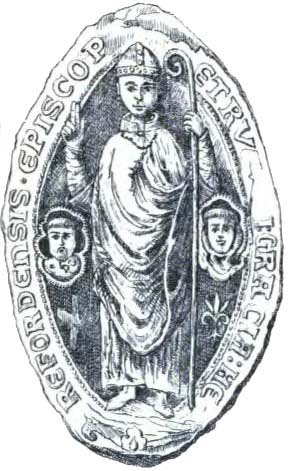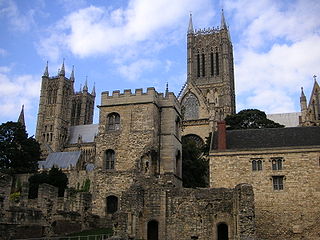Related Research Articles

Peter II, called the Little Charlemagne, was Count of Savoy from 1263 until his death in 1268. He was also holder of the Honour of Richmond, Yorkshire, England, the Honour of the Eagle also known as the Honour of Pevensey and the Honour of Eu also known as the Honour of Hastings. His significant land holdings in Sussex were also marked by his holding of the wardship of John de Warenne, 6th Earl of Surrey which brought with it lands centred upon Lewes castle. Briefly, from 1241 until 1242, castellan of Dover Castle and Keeper of the Coast. In 1243 he was granted land by the Thames in London where he later built the Savoy Palace.

Roger Northburgh was a cleric, administrator and politician who was Bishop of Coventry and Lichfield from 1321 until his death. His was a stormy career as he was inevitably involved in many of the conflicts of his time: military, dynastic and ecclesiastical.
Sir Bertram de Criol was a senior and trusted Steward and diplomat to King Henry III. He served as Constable and Keeper of Dover Castle, Keeper of the Coast and of the Cinque Ports, Keeper of the receipts, expenses and wardships of the archbishopric of Canterbury, Constable of the Tower of London and Sheriff of Kent.
Ralph Neville was a medieval clergyman and politician who served as Bishop of Chichester and Lord Chancellor of England. Neville first appears in the historical record in 1207 in the service of King John, and remained in royal service throughout the rest of his life. By 1213 Neville had custody of the Great Seal of England, although he was not named chancellor, the office responsible for the seal, until 1226. He was rewarded with the bishopric of Chichester in 1222. Although he was also briefly Archbishop-elect of Canterbury and Bishop-elect of Winchester, both elections were set aside, or quashed, and he held neither office.

The Dean of St Patrick's Cathedral is the senior cleric of the Protestant St Patrick's Cathedral, Dublin, elected by the chapter of the cathedral. The office was created in 1219 or 1220, by one of several charters granted to the cathedral by Archbishop Henry de Loundres between 1218 and 1220.

Peter of Aigueblanche was a medieval Bishop of Hereford. A nobleman from Savoy, he came to England as part of the party accompanying King Henry III's bride Eleanor of Provence. He entered the royal service, becoming bishop in 1241. He then served the king for a number of years as a diplomat, helping to arrange the marriage of Prince Edward. Peter became embroiled in King Henry's attempts to acquire the kingdom of Sicily, and Peter's efforts to raise money towards that goal brought condemnation from the clergy and barons of England. When the barons began to revolt against King Henry in the late 1250s and early 1260s, Peter was attacked and his lands and property pillaged. He was arrested briefly in 1263 by the barons, before being mostly restored to his lands after the Battle of Evesham.

William de la Zouche (1299–1352) was Lord Treasurer of England and served as Archbishop of York from 1342 until his death.

The King's Wardrobe, together with the Chamber, made up the personal part of medieval English government known as the King's household. Originally the room where the king's clothes, armour, and treasure were stored, the term was expanded to describe both its contents and the department of clerks who ran it. Early in the reign of Henry III the Wardrobe emerged out of the fragmentation of the Curia Regis to become the chief administrative and accounting department of the Household. The Wardrobe received regular block grants from the Exchequer for much of its history; in addition, however, the wardrobe treasure of gold and jewels enabled the king to make secret and rapid payments to fund his diplomatic and military operations, and for a time, in the 13th-14th centuries, it eclipsed the Exchequer as the chief spending department of central government.

William de Forz, 4th Earl of Albemarle played a conspicuous part in the reign of Henry III of England, notably in the Mad Parliament of 1258.

Stephen de Segrave was a medieval Chief Justiciar of England.

Hugh of Wells was a medieval Bishop of Lincoln. He began his career in the diocese of Bath, where he served two successive bishops, before joining royal service under King John of England. He served in the royal administration until 1209, when he was elected to the see, or bishopric, of Lincoln. When John was excommunicated by Pope Innocent III in November 1209, Hugh went into exile in France, where he remained until 1213.
William Hamilton was deputy chancellor of England from 1286 to 1289, then Lord Chancellor from 1305 to his death on 20 April 1307. He was also Dean of York.
Ravenstone Priory was a medieval monastic house in Buckinghamshire, England. It was established c.1255 and was dissolved in 1524.

Butley Priory, sometimes called Butley Abbey, was a religious house of Canons regular in Butley, Suffolk, dedicated to The Blessed Virgin Mary. It was founded in 1171 by Ranulf de Glanville, Chief Justiciar to King Henry II (1180-1189), and was the sister foundation to Ranulf's house of White canons (Premonstratensians) at Leiston Abbey, a few miles to the north, founded c. 1183. Butley Priory was suppressed in 1538.

William II de Cantilupe, 2nd feudal baron of Eaton Bray in Bedfordshire, was an Anglo-Norman magnate.
William Devereux, was an important Marcher Lord, and held Lyonshall Castle controlling a strategically vital approach to the border of Wales. The castle's significance was heightened by the rebellion of Llywelyn ap Gruffudd, Prince of Wales. With strong family ties to the politically powerful families of Cantilupe and Giffard, his support was strongly sought after by Henry III and Simon de Montfort throughout the Second Barons' War.
John du Plessis or Plessetis, Earl of Warwick was an Anglo-Norman nobleman in the service of King Henry III of England.
Hugh Murdac was an English clergyman and canon of York Minster in the 12th and 13th centuries.
John Crakehall was an English clergyman and Treasurer of England from 1258 to 1260. Possibly the younger son of a minor noble family in Yorkshire, Crakehall served two successive bishops of Lincoln from around 1231 to the 1250s. He then became an archdeacon in the diocese of Lincoln before being named as treasurer, where he served until his death in 1260. He owed his appointment to the treasurership to a number of factors, including his reputation for administrative ability and his relationship with the leader of the baronial effort to reform royal government. While in office, he strove to improve the administration of the exchequer as well as collect outstanding debts to the government and improve royal revenues.
References
- ↑ Tout, T. F. (1920). "Chapters in the administrative history of mediaeval England : the wardrobe, the chamber, and the small seals". archive.org.
- ↑ Wild, B. J. (2012). "Royal finance under King Henry III, 1216—72: the wardrobe evidence". The Economic History Review. 65 (4): 1391. doi:10.1111/j.1468-0289.2011.00641.x. JSTOR 23271694. S2CID 154188870.
- ↑ Stacey, Robert (2004). "Peter Chaceporc". Oxford Dictionary of National Biography (online ed.). OUP. doi:10.1093/ref:odnb/5009.(Subscription or UK public library membership required.)
- ↑ Matthew Paris, (ed. Luard) (1880). "Chronica Majora". archive.org. Longman & co.
- ↑ "Fine Roll No.116". Fine Rolls Henry III.
- ↑ "Fine Roll No.685". Fine Rolls Henry III.
- ↑ Greenaway, Diana (1968). Fasti Ecclesiae Anglicanae 1066-1300: Volume 1, St. Paul's, London. London. pp. 60–1.
{{cite book}}: CS1 maint: location missing publisher (link) - ↑ Page, W. (ed.). "VCH Buckinghamshire". British History Online.
- ↑ Dugdale, ed. Bohn (1846). "Monasticon Anglicanum". archive.org.